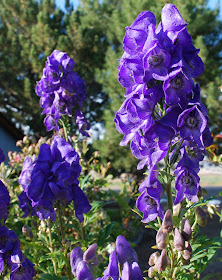When the conditions are right, plants that set seeds unimpeded can replicate themselves by way of breezes, birds, and the intentional flinging of masses of tiny seeds by bursting seed pods. Many of these plants are welcome, filling in empty spots and forming sturdy plants you can share with fellow gardeners.
But often such plants make pests of themselves. We set out to deadhead spent flowers before they form seed pods, but it doesn't always happen on time.
Below, a by-no-means comprehensive list of some of the more beautiful re-seeders in my garden:
The early spring anemone silvestris, which forms a puffy seedball that blows about in the breeze under the shade of the trees until the seeds drop on moist soil and start over again. Accompanying the anemones are violets, another prolific reseeder.
The dog-violet, one of the most aggressive of all reseeders. These will form hardy clumps that are difficult to dislodge from the soil. They will tolerate a lawn mower going over the top of them, which limits the size of the plants. It's kind of nice to have violets in the lawn, if you are not a lawn purist.
Many varieties of columbine will readily reseed themselves. I have found columbines in all parts of the shadier spots in my garden. I usually love them enough to not mind. In the picture above, a compact, upright variety of columbine has reseeded itself among the heuchera and Lady's Mantle.
The pink Missouri primrose may need encouragement if things get too crowded.
Prairie Mallow pops up everywhere. Sometimes the spot of color is appreciated, sometimes it ends up looking like a wilted rag. Pull up when they are young, for when they are established, you will need a sharp shovel.
I never knew that the whirling butterflies plant, the Gaura, could be such a nuisance. I love these plants, but they are impossible to keep in check. These are impossible to photograph, too. Anything tall and slender with small flowers on a long stem presents a challenge to the photographer.
No one minds more plants like these showing up spontaneously. If you can get Phlox Paniculata to cross-pollinate with neighboring plants, you can have a steady stream of lovely color combinations.
The herb garden seems especially prone to seeding itself beyond all control. It makes one wonder how the tidy old Victorian herb gardens kept so tidy--no doubt it took constant work by pruning clipper-wielding-servants. Above, the Matricaria chamomile of the Aster family shows up in the strangest places. I love the fluffy little white blooms, but then they dry and turn dirty brown and set seeds, all of them fertile.
This is Melissa Officinalis, the Lemon Balm. This has invaded sunny parts of the yard front and back. Don't let this plant loose, no matter how much you love the lemon scent.
Chives, another innocent looking Master of the Universe. As long as you like the smell of onion, you won't mind letting these papery globes of lilac-pink turn into tiny little black seeds, all of which fly in all directions, and all of which germinate.
Do not, under any circumstances, grow one of the most aggressive and ultimately unwanted of all herbs, (other than Borage or Horseradish, but that is another story,) spearmint or peppermint (not so much the chocolate mint, which is more restrained) in anything but a deep bucket. Even the bucket spills plants over the side, all of which seed and germinate, or the roots grow out of the holes in the bottom. Chocolate mint (Mentha x piperita subspecies citrata) by the way, smells exactly like that. Irresistible. Which is why we keep growing mints.
Flat leaf parsley. This plant looks good all season and covers up bare spots. You can go out with scissors and decimate it regularly. It grows back.
Hardy blue salvia. Its propensity to spread itself in sunny areas should not have been a surprise to me. Since it is not outrageously aggressive, and since I love the spiky blue over a long bloom season, I often let it stay. I only wish my white salvia would be so generous.
Pastel yarrow, the achillea milllefolium, another plant from the Aster family, is like the blue salvia--fairly tidy all season, giving spots of color where it will blend nicely.
Volunteer goldenrod. Vast potential for reseeding. I haven't gotten tired of these yet. Maybe next year.
White annual alyssum is one of the best established recurring annuals, forming a sprawling, ever-blooming, fragrant and dependable front-of-the-border plant. The lavender blue perennial aster can get rambunctious in the right circumstances, but is easy to pull up, the colors are lovely, the foliage and plant are nice-looking, and everyone wants a piece of it.





















.jpg)






























